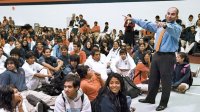10 Takeaway Tips for a College-Bound School Culture
Bold ideas from YES Prep North Central, a successful Houston charter school.
Your content has been saved!
Go to My Saved Content.At YES Prep North Central, the college-bound culture, high-octane teaching practices, and strong relationships -- among students, among teachers, and among teachers and students -- all fit together like pieces of a jigsaw puzzle. But each approach, taken on its own, represents a powerful way of thinking about education. As a handful of Houston schools begin to borrow from YES Prep's model, they are finding that key reforms can work on an incremental basis. Here are some of the most effective strategies for success:
Institute a Strong Discipline Policy
Staff members emphasize that students are responsible for themselves and their school community at YES Prep, and they work proactively with kids to build good behavioral skills, which include appearance as well as demeanor. (Shirts must be tucked in at YES Prep.) The policy is working: There were only two fights on campus last year.
Infuse the School with a College-Bound Culture
Pennants, posters, and slogans on almost every wall of the school broadcast the ultimate goal of getting into college. Members of the school faculty insist that every student will go to college, and they take students to university campuses to give them a flavor of the experience.
Be Available to Students After Hours
YES Prep provides each teacher with a cell phone, which students know they can call in the evenings if they don't understand their homework. This strategy eliminates excuses for not getting the work done.
Create Advisory Periods to Strengthen Relationships
Every day after lunch, each YES Prep staff member meets with the same group of students to discuss current challenges, academic or personal. Advisory groups are designed to serve as supportive families within the school.
Learn from Each Other's Expertise
Even great athletes need coaches, and the same goes for teachers. At YES Prep, teachers take a lead in supporting and coaching each other at weekly grade-level meetings. The school also stages an annual "observation challenge," when teachers pop into each other's classrooms to observe and give feedback.
Extend the Learning Time
The YES school day runs from 7:30 a.m. to 4:30 p.m., five days a week, with sessions every sixth Saturday morning for extra instruction such as SAT practice, and community service. School leaders explain that the extra time is necessary to give students thorough preparation for college and accustom them to a rigorous professional work schedule. Just having great teachers isn't enough, says YES Prep founder Chris Barbic. Students also need added time with those teachers.
Try Team Teaching to Support Vulnerable Students
Educators at YES Prep, which serves students in grades 6-12, say the first year or two at the school, as students adjust to high expectations and long hours, can be a struggle. To help with the transition, teachers in sixth and seventh grades teach in pairs, sharing a classroom and handling larger numbers of students at once. This strategy enables them to get to know kids better, address problems with individual students, and create lessons that integrate various subjects, a step that makes the lessons more realistic and engaging.
Build the Meaning of Education Through Community Service
An additional goal at YES Prep, besides getting kids into and through college, is to ensure that graduates return to Houston and use their education to better the community. At North Central, students spend every sixth Wednesday doing community service. Each grade level chooses a theme for the year; this year's seniors, for instance, are focusing on local elementary schools. Student leaders choose projects on the selected theme. Every sixth Saturday, the teens help teachers organize community events and outreach activities for the neighborhoods around the school. Teacher Craig Brandenburg explains that by making community service a regular practice, "that just becomes who you are."
Set the Tone With a Student-Parent Contract
Before each student starts at YES Prep, a staff member visits his or her home to collect signatures on the family contract. "YES Prep is not just a school. YES Prep is a way of life," begins the document, which details the rigorous requirements of a college-prep program. Educators use the contract as a way to engage with parents, and to emphasize that success is possible only when students, parents, and teachers work together. Later, if the student's commitment slips, they can use the contract as a teaching tool to help get the student back on track.
Give Teachers Input and Shared Responsibility for Excellence
School Director Mark DiBella regularly seeks ideas and feedback from his staff, and intentionally recruits teachers who are different from him, to ensure a diversity of perspectives at the school. Grade-level chairs lead their colleagues through weekly shared planning sessions, and teams of teachers learn by observing each other in sessions modeled on medical-student rounds. Brandenburg says, "I feel really valued here."
Grace Rubenstein is a senior producer at Edutopia.
Yes Prep North Central
Enrollment
854 | Charter, SuburbanPer Pupil Expenditures
$4567 School • $4567 District • $5455 StateFree / Reduced Lunch
56%DEMOGRAPHICS:
6% English-language learners
